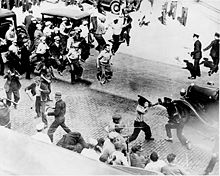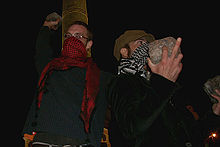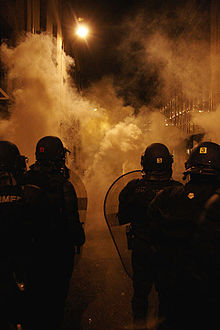- Riot
-
This article is about a type of event. For other meanings of riot, see Riot (disambiguation).
 Teamsters, armed with pipes, riot in a clash with riot police in the Minneapolis Teamsters Strike of 1934.
Teamsters, armed with pipes, riot in a clash with riot police in the Minneapolis Teamsters Strike of 1934.
A riot is a form of civil disorder characterized often by what is thought of as disorganized groups lashing out in a sudden and intense rash of violence against authority, property or people. While individuals may attempt to lead or control a riot, riots are thought to be typically chaotic and exhibit herd behaviour, and usually generated by civil unrest. However, there is a growing body of evidence to suggest that riots are not irrational, herd-like behaviour, but follow inverted social norms.[1]
Riots often occur in reaction to a perceived grievance or out of dissent. Historically, riots have occurred due to poor working or living conditions, government, oppression, taxation or conscription, conflicts between ethnic groups, food supply or religions (see race riot, sectarian violence and pogrom), the outcome of a sporting event (see football hooliganism) or frustration with legal channels through which to air grievances.
Riots typically involve vandalism and the destruction of private and public property. The specific property to be targeted varies depending on the riot and the inclinations of those involved. Targets can include shops, cars, restaurants, state-owned institutions, and religious buildings.
Some rioters have become quite sophisticated at understanding and withstanding the tactics used by police in such situations. Manuals for successful rioting are available on the internet. These manuals also encourage rioters to get the press involved, as there is more safety with the cameras rolling. There is also more attention. Citizens with video cameras may also have an effect on both rioters and police.
Dealing with riots is an often difficult task for police departments. Police may also use tear gas and CS gas to stop rioters. In some countries riot police have moved to using less-than-lethal methods to control riots, such as shotguns that fire flexible baton rounds to injure or otherwise incapacitate rioters for easy arrest.
Contents
Effects of riots
Even when there are understandable reasons for rioting, the riots cause much harm, particularly to the poorest people.[2]
Types of riots
See also: HooliganismA police riot is a term for the disproportionate and unlawful use of force by a group of police against a group of civilians, commonly where police attack a group of peaceful civilians and/or provoke previously peaceful civilians into violence.
A prison riot is a type of large scale, temporary act of concerted defiance or disorder by a group of prisoners against the prison administrators, prison officers, or other groups of prisoners, often to express a grievance, in an attempt to force change or an attempt to escape the prison.
In a race riot race or ethnicity is the key factor. The term had entered the English language in the United States by the 1890s. Early use of the term in the United States referred to race riots which were often a mob action by members of a majority racial group against people of other perceived races.
In a religious riot the key factor is religion.[3] The rioting mob targets people and properties of a specific religion, or those believed to belong to that religion.
Student riots are riots precipitated by students, often in higher education, such as a college/university. Student riots in the US and Western Europe in the 1960s and the 1970s were often political in nature, although student riots can occur as a result of peaceful demonstration oppressed by the authorities and after sporting events (see hooliganism). Students may constitute an active political force in a given country, and student riots may occur in the context of wider political or social grievances.
Urban riots are riots in the context of urban decay, provoked by conditions such as discrimination, poverty, high unemployment, poor schools, poor healthcare, housing inadequacy and police brutality and bias. Urban riots are closely associated with race riots and police riots. In India, for instance, caste riots have tended to be limited to rural theatres while religious riots centred around urban agglomerations.
Sports riots can be sparked by the losing or winning of a specific team, such as the Nika riots. Fans of the two teams may also fight. In North America, they are generally seen in two sports, hockey and association football. Players rarely join in such riots, which usually occur in and around the playing field (in association football) or in the streets or stands (in hockey).
Food and bread riots are caused by harvest failures, incompetent food storage, hoarding, poisoning of food, or attacks by pests like locusts. When the public becomes too desperate in such conditions, they attack shops, farms, homes, or government buildings to obtain bread or other staple foods like grain or salt, as in the 1977 Egyptian Bread Riots.
Many governments and political systems have fallen after riots, including:
- Tsarist Russia,
- The Confederate States of America (see the Southern Bread Riots for an example),
- Ancien Regime,
- British rule in India (bread and salt riots hastened the withdrawal in 1947).
Riot history
Further information: List of riotsPolice response
Main article: Riot controlRiots are typically dealt with by the police (riot control), although methods differ from country to country. Tactics and weapons used can include attack dogs, water cannons, plastic bullets, rubber bullets, pepper spray, flexible baton rounds, and snatch squads. Many police forces, such as the London Metropolitan Police Service, have dedicated divisions to deal with public order situations (see Territorial Support Group, Special Patrol Group, Compagnies Républicaines de Sécurité, Mobiele Eenheid, Arrest Units).
The policing of riots has been marred by incidents in which police have been accused of instigating or provoking rioting or crowd violence (see Police riot); also, while the weapons described above are officially designated as non-lethal, a number of people have allegedly died or been injured as a result of their use.
Deterrents
A high risk of being arrested is even more effective against rioting than severe punishments.[2][dubious ]
As more and more people join the riot, the risk of being arrested goes down, which persuades still more people to join. This leads to a vicious circle, which is typically ended only by sufficient police or military presence to bring up the risk of being arrested. [2]
National laws against riots
India
In India, rioting is an offence under the Indian Penal Code (IPC).
United Kingdom
England and Wales
Riot is a statutory offence in England and Wales. It is created by section 1(1) of the Public Order Act 1986. Sections 1(1) to (5) of that Act read:
- (1) Where 12 or more persons who are present together use or threaten unlawful violence for a common purpose and the conduct of them (taken together) is such as would cause a person of reasonable firmness present at the scene to fear for his personal safety, each of the persons using unlawful violence for the common purpose is guilty of riot.
- (2) It is immaterial whether or not the 12 or more use or threaten unlawful violence simultaneously.
- (3) The common purpose may be inferred from conduct.
- (4) No person of reasonable firmness need actually be, or be likely to be, present at the scene.
- (5) Riot may be committed in private as well as in public places.
A single person can be liable for an offence of riot when they use violence, provided that it is shown there were at least twelve present using or threatening unlawful violence.
"Violence"
This word is defined by section 8. The violence can be against the person or against property.
Mens rea
The mens rea is defined by section 6(1).
Restriction on institution of proceedings
See section 7(1)
Indictment
See R v Tyler and others, 96 Cr App R 332, [1993] Crim LR 60, CA.
Mode of trial and sentence
Riot is an indictable-only offence. A person convicted of riot is liable to imprisonment for any term not exceeding ten years, or to a fine, or to both.[4]
See the following cases:
- R v Luttman [1973] Crim LR 127, CA
- R v Pilgrim, 5 Cr App R (S) 140, CA
- R v Keys, 84 Cr App R 204, 8 Cr App R (S) 444, [1987] Crim LR 207, CA
- R v Cooke, 9 Cr App R (S) 116, CA
Association football matches
In the case of riot connected to football hooliganism, the offender may be banned from football grounds for a set or indeterminate period of time and may be required to surrender their passport to the police for a period of time in the event of a club or international match, or international tournament, connected with the offence. This prevents travelling to the match or tournament in question. (The measures were brought in by the Football (Disorder) Act 2000 after rioting of England fans at Euro 2000.[5])
Compensation for riot damage
See the Riot (Damages) Act 1886 and section 235 of the Merchant Shipping Act 1995..
Interpretation
See section 10 of the Public Order Act 1986 for the construction of "riot" and cognate expressions in other instruments.
Common law offence
The common law offence of riot was abolished[6] for England and Wales[7] on 1 April 1987.[8]
History
In the past, the Riot Act had to be read by an official - with the wording exactly correct - before violent policing action could take place. If the group did not disperse after the Act was read, lethal force could legally be used against the crowd. See also the Black Act.
Section 515 of the Merchant Shipping Act 1894 formerly made provision for compensation for riot damage.
Scotland
There is an offence under the law of Scotland which is known both as "mobbing" and "mobbing and rioting".
United States
Under United States federal law, a riot is defined as:
A public disturbance involving (1) an act or acts of violence by one or more persons part of an assemblage of three or more persons, which act or acts shall constitute a clear and present danger of, or shall result in, damage or injury to the property of any other person or to the person of any other individual or (2) a threat or threats of the commission of an act or acts of violence by one or more persons part of an assemblage of three or more persons having, individually or collectively, the ability of immediate execution of such threat or threats, where the performance of the threatened act or acts of violence would constitute a clear and present danger of, or would result in, damage or injury to the property of any other person or to the person of any other individual.18 U.S.C. § 2102.
As every state in the United States has its own laws (subject to the Supremacy Clause), each has its own definition of a riot. In New York State, for example, the term riot is not defined explicitly, but under § 240.08 of the N.Y. Penal Law due to the fact there was much fighting in the streets, "A person is guilty of inciting to riot when one urges ten or more persons to engage in tumultuous and violent conduct of a kind likely to create public alarm."
See also
- Riot Acts
- Civil disorder
- Secession
- Collective Effervescence
- Demonstration
- Internal security
- List of riots
- Protest
- Pogrom
- Police
- Riot gun
- Rebellion
- Revolution
- Class conflict
- Poll Tax Riots
- Urban riots
- 2007–2008 world food price crisis
- Southern Bread Riots
- Boston Bread Riot
- Flour Riot of 1837
- 1977 Egyptian Bread Riots
- Lynching
References
- ^ You won't prevent future riots by disregarding the psychology of crowds, The Guardian, Aug 19, 2011
- ^ a b c How Riots Start, and How They Can Be Stopped: Edward Glaeser, Edward Glaeser, Bloomberg.com, Aug 12, 2011
- ^ "Thrown pig leads to religious riots in India". CNN. July 3, 2009. http://www.cnn.com/2009/WORLD/asiapcf/07/03/india.pig.religious.riot/index.html. Retrieved May 22, 2010.
- ^ The Public Order Act 1986, section 1(6)
- ^ http://www.legislation.gov.uk/ukpga/2000/25/notes/contents
- ^ The Public Order Act 1986, section 9(1)
- ^ The Public Order Act 1986, section 42
- ^ The Public Order Act 1986 (Commencement No. 2) Order 1987, article 2 and Schedule (1987/198 (C. 4))
- Blackstones Police Manual Volume 4 General police duties, Fraser Simpson (2006). pp. 245. Oxford University Press. ISBN 0-19-928522-5
Further reading
- Applegate, Col. Rex (1992). Riot Control: Materiel and Techniques. Paladin Press. ISBN 9780873642088.
- Beene, Capt. Charles (2006). Riot Prevention and Control: A Police Officer's Guide to Managing Violent and Nonviolent Crowds. Paladin Press. ISBN 1581605188.
- Bessel, Richard Emsley, Clive (2000). Patterns of Provocation: Police and Public Disorder. Berghahn Books. ISBN 1571812288.
- Hernon, Ian (2006). Riot!: Civil Insurrection from Peterloo to the Present Day. Pluto Press. ISBN 0745325386.
- Waddington, P. A. J. (1991). The Strong Arm of the Law: Armed and Public Order Policing. Clarendon Press. ISBN 0198273592.
External links
Categories:- Riots
- Protests
- Civil disobedience
Wikimedia Foundation. 2010.


